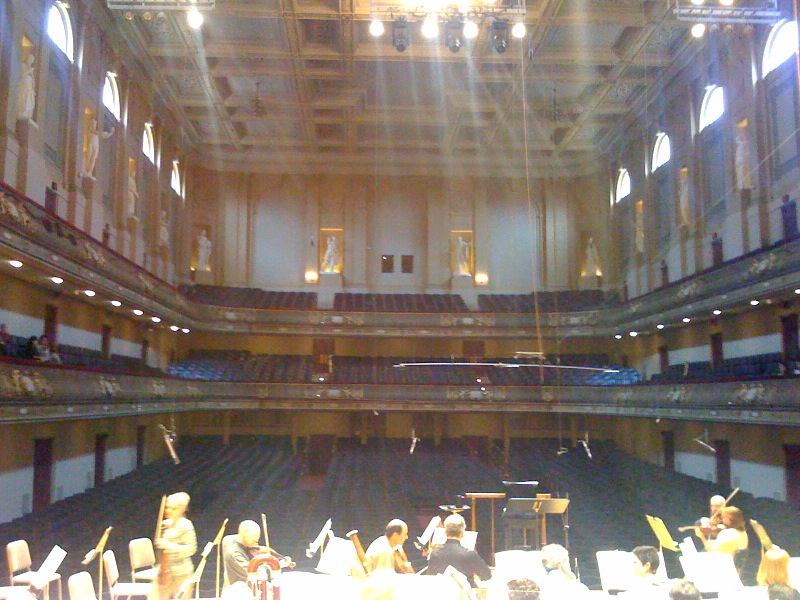As promised earlier, I thought I’d jot down a few thoughts about our performances of the Requiem this weekend, now that I have some distance on the music (meaning: the third movement fugue is no longer obsessively pounding in my head).
I have a long history with the Requiem. I first almost performed it in the late 1990s with the Cathedral Choral Society in Washington, DC, but a family death took me away from the performance after I had almost completely learned it. I finally got a chance to sing it in 2004 with the University Presbyterian Church choir in Seattle, but in English and with a bad head cold. The first time I performed any of it in German was our tribute to Lorraine Hunt Lieberson at Tanglewood in 2006, when we sang the fourth movement (“Wie lieblich sind deine Wohnungen”).
But of course, any performance of a full work with the Tanglewood Festival Chorus is different from any prior performance of the same work, for the simple reasons that (a) you’re singing with one of the best orchestras in the world and (b) you’re doing it from memory. In this case, that’s seventy-five minutes of German, including two bloodying fugues, by heart.
So my perspective on the Requiem has two aspects: one rather like a marathoner’s perspective regarding his last run, and one of a participant in the creation of great beauty.
From the former perspective: pacing is the biggest problem in singing the Brahms, because there are three Heartbreak Hills. The first and fifth movements are calm and fairly easy to sing, the fourth and seventh are louder but also even tempered. But each of the other movements has its own unique challenges. The second movement has those stretches of the funeral chant (“Denn alles Fleisch es ist wie Gras…”) that are sung over the full orchestra at forte volume, down in the bottom of everybody’s tessitura. And then there’s the “Aber des Herrn” at fortissimo, followed by a nice fuguelike section which is thick and inspires a certain tendency to shout. And the third and sixth movements have full-on fugues and climaxes–they’d both be finales in a lesser composer’s hands. Plus, even in the low and medium movements, you have challenges — for the tenors, there’s the high A near the end of the first movement and the final “wie lieblich”, which calls for the tenors to do a very controlled crescendo at a very high point in the range while keeping extremely beautiful tone. So the profile of the work from an emotional perspective is low – high – very high – moderate – low – very high – high, but the technical difficulty profile is basically high – very high – very high -high – high – very freaking high – high, and you have to really husband your emotional and physical energy accordingly.
The alternative: you hit the wall sometime around the sixth movement, the real uphill battle of the work, before you even get into the fugue. And in that fugue, as our director said, there is inevitably “blood on the walls” in every performance thanks to the demand on the singers and the difficulty of the preceding music. So the secret is to remember what’s ahead and never, ever, ever go full volume. If the director asks for more in a climatic crescendo, focus the voice up into the face so that it projects more clearly, rather than simply opening up to full vocal throttle.
From the second perspective: I’ve never sung in a performance where every chorister was so on top of the music, and so together–total telepathic connection from person to person. And every one of them singing right to the limit of the safe range of the voice, without going into the danger zone, thanks to lots of “marathon” experience. And with the improved acoustics of Symphony Hall, being able to hear other voice parts as though they were standing right next to you. So performing it was a joy. I can’t pretend to be able to provide an objective review of our own performance otherwise, but if the hall was enjoying it half as much as we were, it’s no wonder they applauded as vigorously as we did.
 A tip from Jonathan Hoefler led me to the NYPL Digital Gallery, now fully searchable and browsable, with low resolution images free for non-profit use (including personal blogs, though not Wikipedia). Some really fascinating stuff, including a number of University of Virginia related items: detailed close-up shots of the pediments of East Lawn, the post-1895 Rotunda, the serpentine walls, two different views of the famous pre-1895 engraving showing the Lawn from the West with the Rotunda annex, a view of the full map of Virginia from which the 1826 engraving of the Lawn is drawn and a separate close-up of that engraving, other early engravings likely not drawn from life (since they don’t show the terraces on the Lawn) but including the pediment around Pavilion X, the exterior and interior of Edgar Allan Poe’s room on West Range following one of the Raven Society restorations of the room, and my personal favorite, pictures from a visit that Gertrude Stein and Alice B. Toklas made to the University in 1935, including a shot with faculty and students, the pair in front of a pavilion, and this nifty shot of Stein in front of the Rotunda.
A tip from Jonathan Hoefler led me to the NYPL Digital Gallery, now fully searchable and browsable, with low resolution images free for non-profit use (including personal blogs, though not Wikipedia). Some really fascinating stuff, including a number of University of Virginia related items: detailed close-up shots of the pediments of East Lawn, the post-1895 Rotunda, the serpentine walls, two different views of the famous pre-1895 engraving showing the Lawn from the West with the Rotunda annex, a view of the full map of Virginia from which the 1826 engraving of the Lawn is drawn and a separate close-up of that engraving, other early engravings likely not drawn from life (since they don’t show the terraces on the Lawn) but including the pediment around Pavilion X, the exterior and interior of Edgar Allan Poe’s room on West Range following one of the Raven Society restorations of the room, and my personal favorite, pictures from a visit that Gertrude Stein and Alice B. Toklas made to the University in 1935, including a shot with faculty and students, the pair in front of a pavilion, and this nifty shot of Stein in front of the Rotunda.

